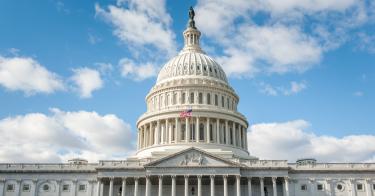British art historian Kenneth Clark said in the opening of “Civilisation,” his famed 1969 BBC series, that “if I had to say which was telling the truth about society, a speech by a Minister of Housing or the actual buildings put up in his time, I should believe the buildings.”
As if to illustrate his point, only a year earlier the headquarters of the recently formed Department of Housing and Urban Development had opened in Washington—the antithesis incarnate of what housing and urban development should be.
It would be among the earliest of many federal structures in the city to embrace this new style. Praised by some, excoriated by many, if these iterations of modernism tell the truth about American society, it would be an ugly one indeed.
The debate over the federal government’s embrace of modern architecture has restarted 50 years on with the introduction of the Beautifying Federal Civic Architecture Act by Rep. Jim Banks of Indiana and Sen. Marco Rubio of Florida, both Republicans.
Modeled on former President Donald Trump’s Promoting Beautiful Federal Civic Architecture executive order (later overturned by President Biden), the bill would establish preference for traditional and classical architecture in the construction and renovation of federal buildings.
The original executive order, issued in December 2020, was denounced by architects and political pundits alike, for reasons as varied as fascism and White supremacy.
The American Institute of Architects decried the order, ironically declaring that it “inappropriately elevates the design tastes of a few federal appointees over the communities in which the buildings would be placed.”
Never mind that the vast majority of Americans prefer traditional civic buildings and would like to see more of them.
Those vast edifices of bureaucracy that have been imposed on U.S. cities over the last 70 years range from oppressive to mundane, frigid to bizarre, but they all fail to please.
These temples of banality leave the American public unmoved because they neglect beauty for novelty and exalt the ego of the architect over the experience of the visitor.
Age-old principles of proportion, symmetry, and regard for human scale have been discarded.
The heart of this disagreement is not the extolling of one architectural style over others of equal significance. Rather, both Mr. Trump’s executive order and the new bill are reactions against the inhuman compositions that have come to define architecture for decades.
It is no mere squabbling between Renaissance and rococo, but a recognition that modern and postmodern styles, whether internationalist, brutalist or deconstructivist, have all abandoned beauty.
That beauty and aesthetics should play any role in the design of a structure has been derided ever since Chicago architect Louis Sullivan’s dictum “form follows function” vanquished the field’s imagination. On the contrary, such a concept of architecture as encouraging transcendence, and ennobling the spirit is unthinkable among the artistic, architectural and political elite, who instead try to lecture the hoi polloi on why these monstrosities are ostensibly preferable.
The average citizen knows better. Why do tourists travel to Rome, to Florence, to Savannah, to Charleston? Why are wedding photos taken at the old post office rather than the new one?
The beauty of a structure (or lack thereof) affects man’s spirit, elevating or lowering his aspirations, his dignity, and ultimately his happiness.
The Banks-Rubio bill implicitly denounces a total aesthetic subjectivity and recognizes that, while there can be many iterations, man can create that which is obviously beautiful or clearly ugly.
Abbot Suger, the 12th-century Frenchman who initiated the construction of the first Gothic cathedral, was guided by his belief that “Man may rise to the contemplation of the divine through the senses,” and designed accordingly.
While the aspirations of a courthouse, library or post office aren’t quite as lofty, they still should encourage the contemplation of the history, virtues and ideals of the nation.
Indeed, the bill states that the architecture employed in federal buildings should “(A) [command] respect from the general public; and (B) clearly [convey] to the general public the dignity, enterprise, vigor, and stability of the system of self-government of the United States.”
Ideas have consequences, and our built environment shapes our moral imagination.
Great buildings define the cityscape, civic identity and culture of their locality. As the British architect Christopher Wren once said: “Public buildings [are] the ornament of a country. [Architecture] establishes a Nation, draws people and commerce, makes the people love their native country. … Architecture aims at eternity.”
Let’s hope that through the spirit of legislation such as the Beautifying Federal Civic Architecture Act, we too might once again build that which is elevating and ennobling.
This piece originally appeared in The Washington Times


